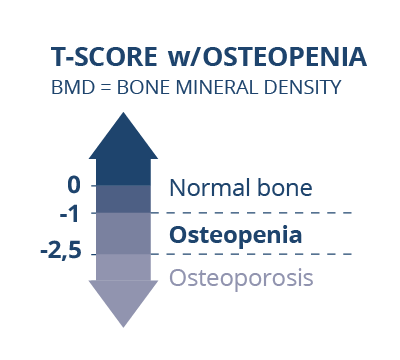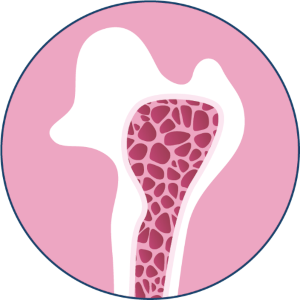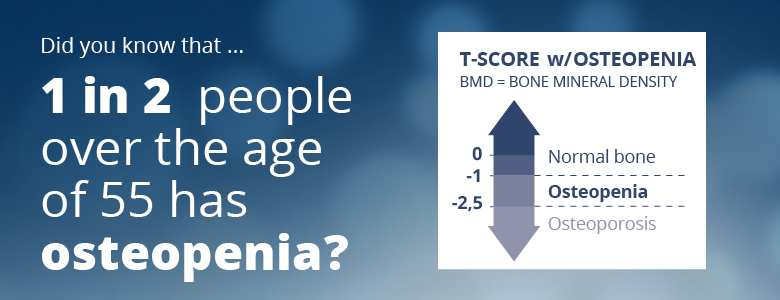What is osteoporosis?
Osteoporosis, also known as brittle bone disease, is a disease characterised by lower bone mass and changes in the structure of bone tissue. This causes the bones to become more brittle, increasing the risk of fractures. The diagnosis is made by means of DXA bone density scans and blood tests. A “T-score” is calculated based on this, which is a calculation of the standard deviation in relation to the average for young healthy people. A diagnosis of osteoporosis is made when the T-score is lower than -2.5 (Nygaard, 2019). A T-score of between -1 and -2.5, on the other hand, is defined as osteopenia. However, this condition is not classed as a disease, but as a deficiency condition in people who are otherwise fit and healthy.

Why do you get osteoporosis?
Osteoporosis is not typically due to any underlying disease. It most commonly develops as a result of hormone deficiency or old age. Hormonal osteoporosis can occur during and after menopause when oestrogen production decreases (oestrogen stimulates bone formation). This type of osteoporosis therefore mainly affects women. This means that, during menopause, women’s bones can decalcify by up to 2-5% per year. After menopause, however, the loss of bone mass decreases to 1-3% per year. (Lambert et al., 2017).
Age-related osteoporosis, on the other hand, occurs as a result of old age, and can affect both sexes. The reason for this type of osteoporosis is that, from the age of 30, people’s bones decalcify by 0.5-1% per year, which ultimately means that the bones can become brittle (Nygaard, 2019-2).
Osteopenia is the precursor to osteoporosis. The reasons for getting osteoporosis are therefore the same as for osteopenia. However, it is important to stress that people with osteopenia are healthy, while people with osteoporosis have a disease.

How many people have osteoporosis?
According to the WHO’s definition of osteoporosis, which, however, only applies to people of Caucasian descent, some 550,000 Danes over the age of 50 have osteoporosis. According to figures provided by the Danish Health Authority (Sundhedsstyrelsen), only around half of them know they have it (Sundhedsstyrelsen, 2018). By comparison, it is estimated that around 1 in 2 people over the age of 55 will have osteopenia if they have a bone scan.

What else can you do about osteopenia?
Important ingredients in the prevention and treatment of osteoporosis include leading a healthy lifestyle. The advice is the same if one is found to have osteopenia. This includes, first and foremost, a healthy diet and plenty of physical activity. In addition, you are recommended to refrain from smoking and consuming large amounts of alcohol.
Sources
-
Lambert, Max Norman Tandrup; Meng Hu, Lin; Jeppesen, Per Bendix (2017: „A systematic review and meta-analysis of the effects of isoflavone formulations against estrogen-deficient bone resporption in peri- and postmenopausal women. The American Journal of Clinical Nutrition, pp.801-811. American Society for Nutrition.
-
Osteoporoseforeningen (2020): ”Osteopeni – hvad er det og hvad nu?”. Osteoporoseforeningen.: https://www.osteoporose-f.dk/knogleskoerhed/osteopeni/ , Visited 26/06-2020
-
Nygaard, Birte (2019): Knogleskørhed, risikofaktorer. Sundhed.dk: https://www.sundhed.dk/borger/patienthaandbogen/hormoner-og-stofskifte/sygdomme/knogleskoerhed-osteoporose/knogleskoerhed-risikofaktorer/, Visited 26/06-2020
-
Sundhed.dk (2020) : https://www.sundhed.dk/borger/patienthaandbogen/hormoner-og-stofskifte/illustrationer/animationer/knogleskoerhed-osteoporose/ , Visited: 26/06-2020
-
Sundhedsstyrelsen (2018): Osteoporose – En afdækning af den samlede indsats mod osteoporose, Version 1.0, Published 18/12-2018 https://www.sst.dk/-/media/Udgivelser/2018/Osteoporose/Osteoporose—en-afd%C3%A6kning-af-den-samlede-indsats.ashx?la=da&hash=AC6E054380B701F2CC24F4208D77A2D69D0F6315


